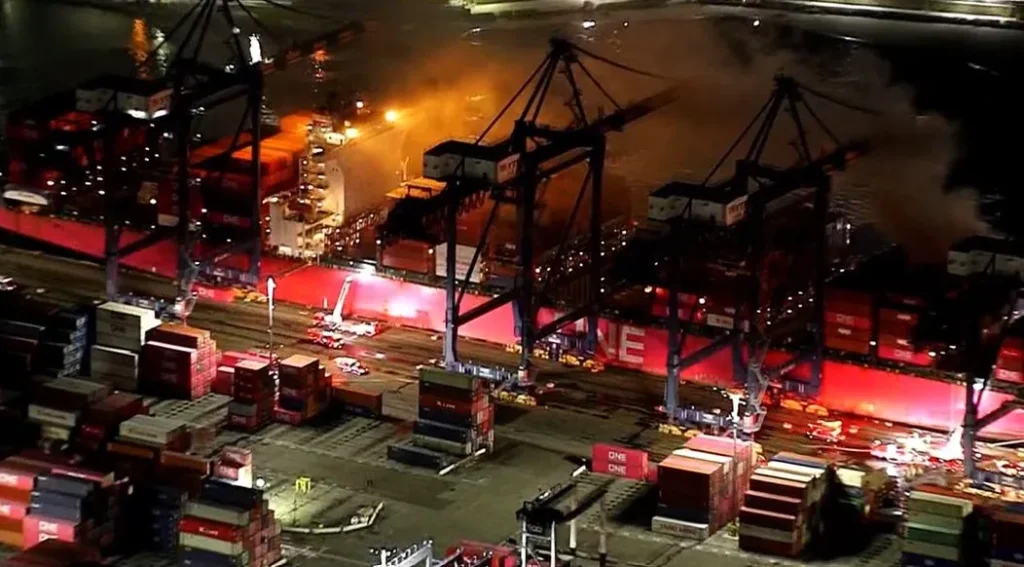Port of Los Angeles Container Ship Fire: Safety Concerns and Swift Response
A dangerous blaze broke out Friday evening aboard the container ship Henry Hudson while docked at the Port of Los Angeles, igniting widespread concern due to the presence of hazardous materials onboard. The incident began around 6:38 PM when the crew first reported the fire, which quickly spread to multiple cargo bays. By 7:13 PM, the Los Angeles Fire Department (LAFD) had mobilized over 100 firefighters to tackle the growing emergency. The situation intensified dramatically at 7:58 PM when an explosion on the mid-deck knocked out power and lighting systems, also affecting crane operations crucial for firefighting efforts. Despite these challenges, the LAFD confirmed by 8:34 PM that all crew members had been accounted for with no injuries reported—a remarkable outcome given the severity of the situation and the dangerous conditions faced by both ship personnel and first responders.
The fire’s complexity was significantly amplified by the confirmed presence of hazardous materials in the affected cargo areas, as indicated on the ship’s manifest. This dangerous reality forced firefighting crews to take extraordinary precautions, working in fully encapsulated suits with self-contained breathing apparatus to protect themselves from potential toxic exposure. Progress in containing the blaze was described as “slow” according to LAFD updates, largely due to the difficulty accessing the multi-level container ship’s sub-levels where flames continued to burn. Throughout the operation, specialized LAFD HazMat teams continuously monitored air quality to ensure the safety of both emergency personnel and surrounding communities. Meanwhile, despite the massive quantities of water being used for fire suppression, authorities carefully monitored the ship’s stability, noting with relief that it remained “stable” in the water—averting what could have been an additional catastrophe had the vessel begun to list or sink under the added weight.
This incident at one of America’s busiest ports highlights the ever-present risks inherent in maritime shipping, particularly when transporting hazardous materials. Modern container vessels like the Henry Hudson represent marvels of global commerce but also present unique firefighting challenges with their maze-like structures and varied cargo. When emergencies occur, the confined spaces, complex layouts, and the potential for toxic atmospheres create extraordinarily dangerous conditions for emergency responders. What begins as a standard fire can quickly escalate into a multi-faceted crisis requiring specialized knowledge, equipment, and tactics—precisely what we witnessed Friday night in Los Angeles as firefighters battled not just flames but also darkness, potentially toxic environments, and the constant threat of further explosions.
The Port of Los Angeles serves as a crucial gateway for international trade, handling approximately $294 billion in cargo annually and supporting countless jobs throughout the region. Any significant disruption to its operations ripples through supply chains nationwide, affecting businesses and consumers alike. Beyond immediate safety concerns, incidents like the Henry Hudson fire raise important questions about port security protocols, emergency preparedness, and environmental protection measures. The port’s location adjacent to residential areas and sensitive marine ecosystems means that hazardous material fires pose risks extending far beyond the immediate dockside. While authorities have not yet reported any significant environmental impacts from this incident, the potential for air pollution, water contamination, or other environmental damage remains a serious concern whenever hazardous materials are involved in maritime emergencies.
The swift response demonstrated by both the ship’s crew and the Los Angeles Fire Department likely prevented this incident from becoming far more catastrophic. Maritime safety experts often emphasize that the first minutes of a shipboard fire are critical, with early detection and immediate action being key factors in successful containment. The crew’s prompt reporting at 6:38 PM gave emergency services precious time to mobilize appropriate resources, including specialized marine units equipped to handle hazardous materials incidents. The deployment of over 100 firefighters—many with specialized training in maritime emergencies—exemplifies the seriousness with which authorities treated this potentially disastrous situation. Their professional approach, despite the explosion and power failure that complicated their efforts, stands as a testament to their training and dedication in protecting both human life and critical infrastructure.
As investigation into the cause of the Henry Hudson fire begins, this incident will likely prompt renewed discussions about safety protocols for vessels carrying hazardous materials, particularly when docked in heavily populated areas. Industry experts, regulatory bodies, and port authorities continuously evaluate and update safety standards, but events like this serve as powerful reminders of the risks that persist despite best practices. The maritime shipping industry, which transports approximately 90% of global trade, must constantly balance operational efficiency with rigorous safety measures. For the Port of Los Angeles and ports worldwide, this incident underscores the need for continued investment in emergency response capabilities, crew training, and hazardous materials handling protocols. While the immediate crisis appears to have been managed without casualties—a outcome worth celebrating—the lessons learned from this fire will undoubtedly inform future safety improvements throughout the maritime industry, potentially preventing similar or worse incidents in the years to come.


